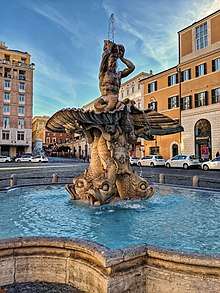Fountains of Rome (symphonic poem)
Fountains of Rome (Italian: Fontane di Roma) is a symphonic poem written by the Italian composer Ottorino Respighi in 1916 and first published in 1918[1]. It was his first great success as a composer and is his best known work.[2] He wrote as sequels two other works: Pines of Rome (1924) and Roman Festivals (1928).[2]
Each of the four movements depicts one of Rome’s fountains at a different time of the day.
Its premiere was held on March 11, 1917 at the Teatro Augusteo in Rome, under the direction of Antonio Guarnieri.
Structure
The first section, "The Fountain of Valle Giulia at Dawn" (La fontana di Valle Giulia all'Alba), shows this fountain at daybreak in "a pastoral scene, with sheep passing and disappearing in the fresh and humid mist of a Roman dawn".[3]

In the second section, "The Triton Fountain in the Morning" (La fontana del Tritone al mattino), "it is like some joyous appeal at whose sound naiads and Tritons come trooping up, pursuing each other and mingling in a wild dance beneath the falling spray."[3] Figures of the Bernini fountain are seen nearby. The Tritons blow on conch shells, portrayed by the French horns.
The theme of third section, "The Trevi Fountain at Noon" (La fontana di Trevi al meriggio), "takes on a triumphal character. Fanfares sound. It is as if Neptune's chariot, drawn by river-horses and followed by a cortege of sirens and tritons, were passing on the radiant surface of the water, only to vanish while muted chimes sound in the distance."[3]
The final section, "The Villa Medici Fountain at Sunset" (La fontana di Villa Medici al tramonto), portrays a much more melancholic atmosphere. "It is sad in intent, delicate, restful. Bells toll for the Angelus. Birds twitter and there is a rustling and fluttering of leaves. Then follows the silence of night."[3]
Instrumentation
Fountains of Rome calls for the following large orchestra, including piano, celesta, harps, chimes, and organ ad lib.:
- woodwinds: piccolo, 2 flutes, 2 oboes, English horn, 2 clarinets in B-flat and A, bass clarinet in B-flat and A, 2 bassoons
- brass: 4 French horns in F, 3 trumpets in B-flat and A, 3 trombones, tuba
- percussion: timpani, cymbals, triangle, bell in D, glockenspiel
- keyboards: organ (ad lib.), piano, celesta
- strings: 2 harps, violins i, ii, violas, violoncellos, double basses
It was also transcribed for piano four hands (duet) by the composer.[1]
Performances, reception, and recordings
Arturo Toscanini originally planned to conduct the work in 1916, but the Italian composer refused to appear for the performance after a disagreement over his having included some of Wagner's music on a program played during World War I. Consequently, it did not premiere until March 11, 1917, at the Teatro Augusteo in Rome, with Antonio Guarnieri as conductor. Although the premiere was unsuccessful, Toscanini finally conducted the work in Milan in 1918 with tremendous success. It "was acclaimed [as] one of the loveliest of symphonic writings".[4]
The piece was first performed in the United States on February 13, 1919. Toscanini recorded the music with the NBC Symphony Orchestra in Carnegie Hall in 1951; the high fidelity monaural recording was issued on LP and then digitally remastered for release on CD by RCA Victor. The work has since become one of the most eminent examples of the symphonic poem.
Use in popular culture
The Second Movement appears on the Hong Kong Film Studios Feng Hua as intro.
References
- "Fontane di Roma (Respighi, Ottorino) - IMSLP/Petrucci Music Library: Free Public Domain Sheet Music". imslp.org. Retrieved 2017-10-10.
- "(Program notes)" (PDF). University of Washington Symphony Orchestra. 2007. Retrieved April 7, 2020.
- "The Three Arts". The Evening Sun (Baltimore, Maryland). 28 December 1920. p. 12 – via newspapers.com.
- "La Scala Orchestra". Pittsburgh Daily Post. 27 February 1921. p. 39 – via newspapers.com.
- Program notes by Stephanie von Buchau, written for Deutsche Grammophon's production of the recording by the Berlin Philharmonic, conducted by Herbert von Karajan.